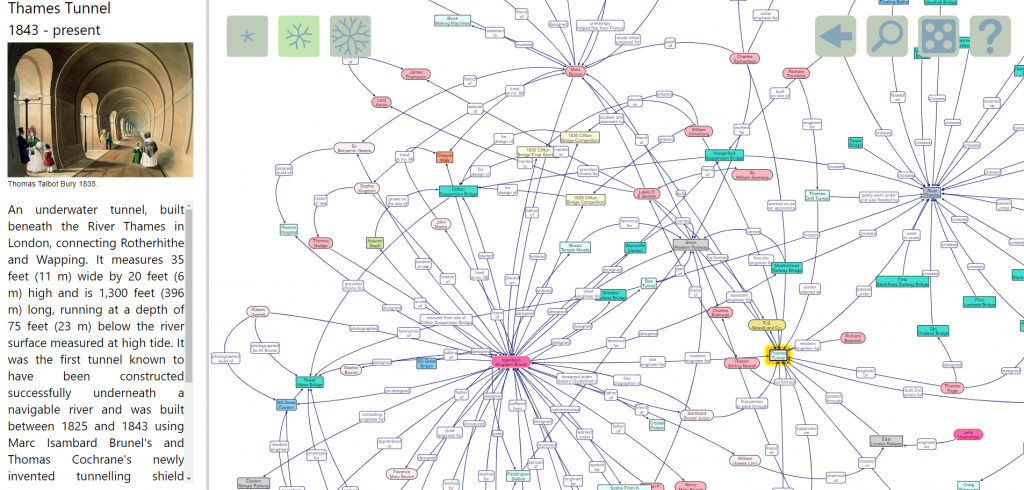Have you ever wondered whether all the famous Victorian engineers knew each other? Who worked on what with whom? How other famous names of the Victorian era fit into this picture?
Did you know that Mark Brunel was friends with Alexander Hamilton (yes, THAT Hamilton)? Are you curious about who else worked on the Thames Tunnel? Did you know that Cheyne Walk in Chelsea housed, at various times, not only the Brunels but the painters J.M.W. Turner and D.G. Rossetti, the mathematician / physicist James Clerk Maxwell, and Joseph Bramah – who invented the Hydraulic Press!
The Victorian Engineering Connections Diagram allows a user to explore the connections between Victorian engineers, their achievements and their world. I’m delighted to say that it over-spills beyond both the Victorian time-frame the engineering discipline. This is very deliberate: there’s the ‘standing on the shoulders of giants’ thing and also making connections – especially unexpected ones – can be fun and the purpose of the diagram is to entertain as much as to inform.
The diagram is supposed to be relatively easy to use, but part of the fun is discovering how it works. Having said that, here are a couple of hints: use your usual controls for panning and zooming, click on a node to re-focus on a different node. There’s also a search function if you want to jump to specific node, a basic help system which uses its own mini diagram and also a multi-hop back button.
One word of caution: You can select how many degrees of separation are shown from the focus node – you can choose between a span of one, two or three links. If you choose a span of three links in a busy part of the diagram you can end up with an humongous lot of displayed stuff. Unless you are using a pretty pokey device then things can get a tad slow. If this happens then try a lower span level. If you want to find a busy part of the diagram hop to somewhere in the vicinity of Isambard Kingdom Brunel.
This wonderful diagram was created (and is maintained) by Andrew Martin – here are a few words from him about how it came to be:
The Victorian Engineering Connections diagram started life back in 2018 when I was working as a volunteer on the ‘Hawkshaw and Barlow Untold’ exhibit at the Clifton Suspension Bridge https://www.cliftonbridge.org.uk/hawkshaw-and-barlow-untold
One thing that we wanted to highlight was the fact that engineers rarely (if ever) have ideas in isolation – they are usually influenced by – or build on the work of – other engineers, scientists, architects, artists and the like. I sketched a simple diagram of some of these links. My colleagues immediately suggested more content for the diagram – so I re-drew it. After a few rounds of this it began to get tedious, so I cast around for some way of automating the redrawing process. This eventually led me to create the interactive version was installed as part of the H&B Untold exhibit in the Clifton Suspension Bridge Visitors Centre. That version currently has three hundred or so nodes. I then decided to develop an online version, with some more features and with the potential to handle a significantly larger dataset. Thus the website at http://www.victorianengineeringconnections.net/ (will open at a random node) was born. I am semi-continuously adding more content to the site. At the time of writing the diagram has 1334 nodes and 2584 links.
Thank you, Andrew, for sharing this fascinating resource with all of us!
__________________________________________________________________________________________
Are you interested on reading up on some of the people and projects you’ve explored on the connections diagram? Did you know that if you buy from Amazon you can donate to us at NO COST to yourself – just access Amazon via this link: https://smile.amazon.co.uk/ch/1003287-0 , choose the Brunel Museum as your charity, and they will do the rest. It will not change your Amazon experience or the prices that you see, but Amazon will donate a small amount to the museum, which would especially help us during the COVID-19 crisis, as we no longer have a regular museum income.
|
The Brunel Museum
|
If you would like to be part of shaping the future of the museum, please visit our Community Consultation page.
If you wish to show your support for the museum, please donate via Virgin Giving to our Covid-19 Crisis Appeal, visit our Support Us page and/or peruse our Online Shop.
If you want to keep up to date with Brunel Museum news, please check out our News page and follow us on Social Media: Twitter / Instagram / Facebook. You can also sign up to our newsletter here.
Thank you.


